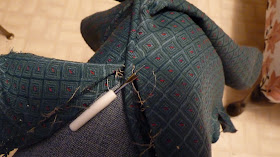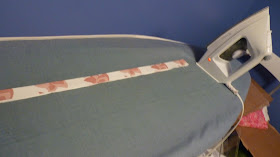Materials & Tools:
- Old ottoman (purchased from 2nd hand store)
- Enough fabric of your choosing to re-cover the outside of the ottoman
- Black fabric to line the interior of the ottoman
- Plywood- Screws
- 2 med-duty hinges
- Drill
- Screwdriver- Staple-gun
- Sewing machine
1) Purchase an inexpensive ottoman from a 2nd hand store with a sturdy frame (doesn't really matter what the outside looks like). Remove the legs and set aside.
4) Measure the length and width of the bottom of your ottoman. Cut plywood to fit. (The thickness of your plywood will depend on how strong you want the floor of your ottoman's interior to be, and also what kind of legs you have for your ottoman. In this case, my legs had fairly short screws, so I needed my plywood to be strong as possible, but also slim, so I chose to go with 1/4" hardboard.?) Position your piece of plywood on the bottom of your ottoman, mark and drill holes of appropriate size to fit your legs.
Screw legs into position to make sure everything fits, make adjustments if necessary.5) Using legs to hold plywood in place, drill holes around the outside perimeter of the plywood, and secure to ottoman frame with screws.
7) Replace bottom covering and legs.
8) Measure the length and width of the top padding of your ottoman. Cut a piece of plywood slightly smaller than your measurements. You may also need to trim back the corners of your plywood slightly on an angle if your top padding does not have perfectly square corners. ?
9) Separate pieces of old fabric covering from the top padding cover of the ottoman at the seams. Iron out pieces and trace onto new fabric. Cut out new fabric pieces (you may need to leave a couple of extra inches at the bottom edge to help secure padding to plywood.) and sew back together in the same manner as the old covering.
10) Place top padding into new fabric covering. Place cut piece of plywood on top, and tightly secure the fabric around the perimeter of the plywood to the plywood with staples.
11) Cut a piece of black lining fabric and stable to bottom of ottoman top to cover plywood and fabric edges.
12) Measure length and height of each of the interior walls and floor of the ottoman, adding enough for seams. Cut out pieces of black lining fabric in accordance with your measurements and sew a case lining for the interior of your ottoman. Place inside of ottoman and secure to ottoman frame around upper and lower perimeters with staples.
13) Position and secure hinges with screws to outside edge of ottoman lid (on the plywood).? Position and secure remaining side of hinges to ottoman box frame with screws, checking to make sure that lid will fit correctly on the ottoman box when closed, adjust if necessary (You may need someone to hold the ottoman lid for you while you do this).
Credited to the Author






















































